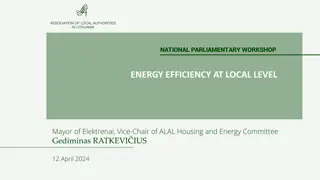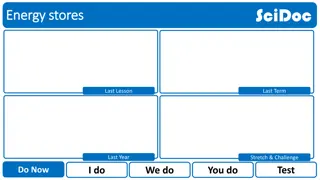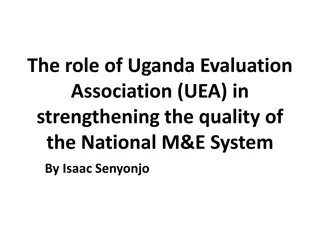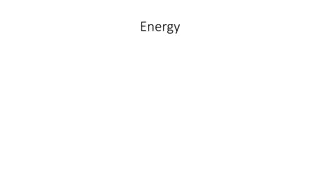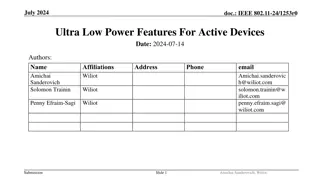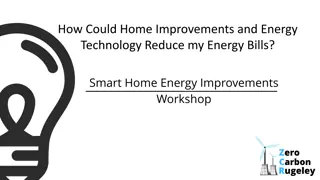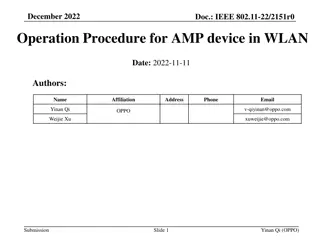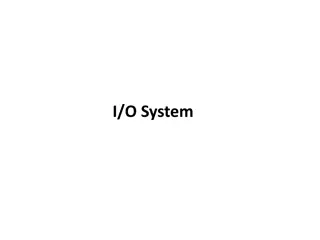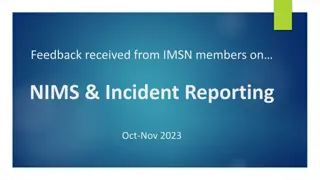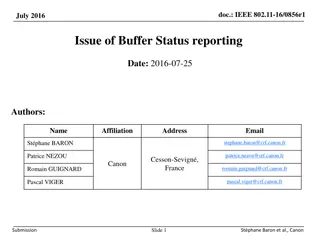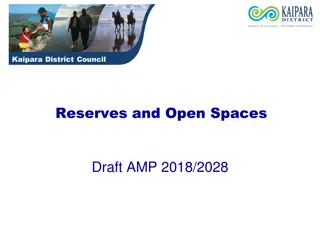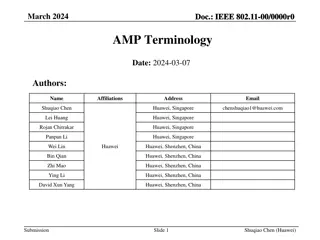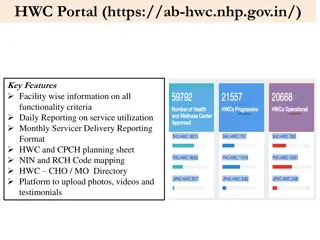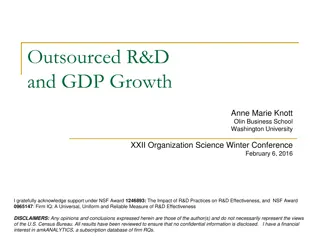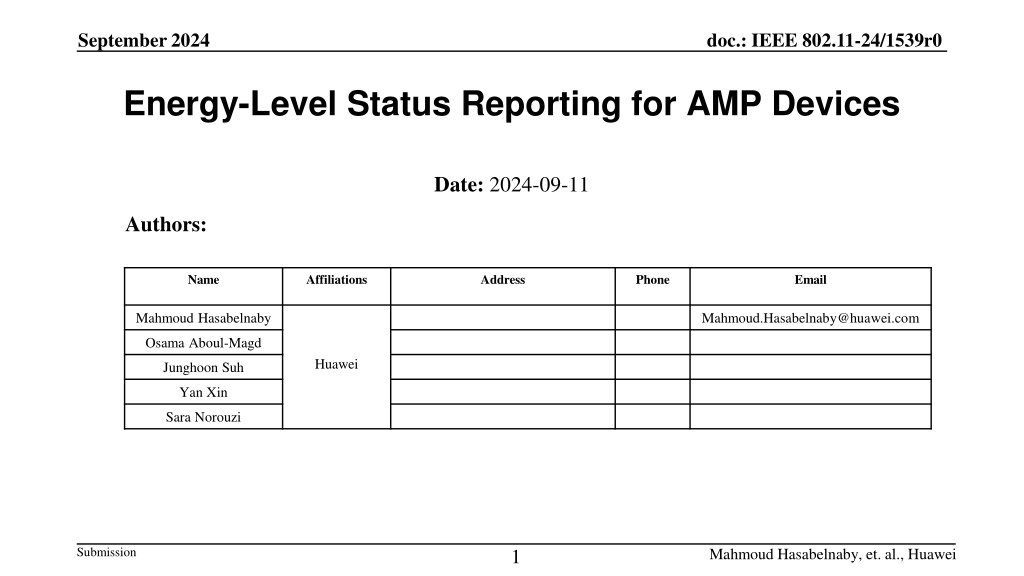
Energy-Level Status Reporting for AMP Devices
In this contribution, energy-level status reporting mechanisms are proposed for AMP STAs to efficiently communicate their current energy state to the AP. Lack of knowledge regarding the energy level of AMP STAs can lead to wasted network resources, poor scheduling decisions, potential data loss, and increased network congestion. By implementing energy-level status reporting, more informed data transmission scheduling and resource allocation can be achieved for improved network efficiency.
Download Presentation

Please find below an Image/Link to download the presentation.
The content on the website is provided AS IS for your information and personal use only. It may not be sold, licensed, or shared on other websites without obtaining consent from the author. If you encounter any issues during the download, it is possible that the publisher has removed the file from their server.
You are allowed to download the files provided on this website for personal or commercial use, subject to the condition that they are used lawfully. All files are the property of their respective owners.
The content on the website is provided AS IS for your information and personal use only. It may not be sold, licensed, or shared on other websites without obtaining consent from the author.
E N D
Presentation Transcript
doc.: IEEE 802.11-24/1539r0 September 2024 Energy-Level Status Reporting for AMP Devices Date: 2024-09-11 Authors: Name Affiliations Address Phone Email Mahmoud Hasabelnaby Mahmoud.Hasabelnaby@huawei.com Osama Aboul-Magd Huawei Junghoon Suh Yan Xin Sara Norouzi Submission Mahmoud Hasabelnaby, et. al., Huawei 1
doc.: IEEE 802.11-24/1539r0 September 2024 Abstract In this contribution, we propose energy-level status reporting (ELSR) mechanisms for AMP STAs to communicate their current energy state to the AP, thereby enabling efficient data transmission scheduling and preventing communication initiation when AMP STAs lack power. 2 Submission Mahmoud Hasabelnaby, et. al., Huawei
doc.: IEEE 802.11-24/1539r0 September 2024 Introduction (1/3) AMP IoT device operates on energy harvested from a diverse range of ambient power sources such as radio waves, sunlight, motion, and heat, eliminating the need for a conventional battery [1]. Depending on the accumulated energy, the AMP STA can be in three states [2]: - NO ENERGY - no action other than energy accumulation - ACTIVE Low energy memory retention, sensing, and other low energy functions. - ACTIVE High energy any activity Energy Supply . . . Active Low Active High Active High Active Low Ambient device state NO_ENERGY RX+ TX Ambient device Activity RX+TX High Ambient device Energy 1 2 3 4 5 6 7 8 9 10 11 Low AMP STA will only be able to communicate when they have enough accumulated energy (ACTIVE High energy). This can be an issue, especially when communication is initiated towards an AMP STA, while it is not known whether the AMP STA has enough energy to receive this communication [3]. 3 Submission Mahmoud Hasabelnaby, et. al., Huawei
doc.: IEEE 802.11-24/1539r0 September 2024 Introduction (2/3) In this case, the AP cannot make informed decisions about data transmission scheduling and resource allocation due to a lack of knowledge regarding the AMP STA's current energy level. This can lead to: - Wasted Network Resources: The AP might allocate time or frequency channel access resources to an AMP STA with insufficient or no stored energy , resulting in wasted network resources and underutilization and inefficient network operation as those resources remain unused. - Poor Scheduling Decisions: Without energy-level information, the AP cannot optimize transmission scheduling. It might prioritize AMP STAs that cannot complete the communication due to their low energy, while other AMP STAs with sufficient energy might be overlooked. This leads to suboptimal scheduling and inefficient resource use. - Without knowledge of the AMP STA's availability for high-energy operations, the AP cannot schedule data transmissions effectively. This can lead to wasted energy and inefficient resource utilization on both the AP and AMP STA sides. - Potential Data Loss: The AP might transmit data or control frames to a low/no energy AMP STA, leading to potential packet loss and transmission failure. - Multiple failed transmission attempts due to energy shortages at AMP STAs could increase network congestion and collisions, as the AP may keep attempting to communicate with energy-depleted AMP STAs, reducing available bandwidth for other devices. 4 Submission Mahmoud Hasabelnaby, et. al., Huawei
doc.: IEEE 802.11-24/1539r0 September 2024 Introduction (3/3) The aforementioned limitations highlight the critical need for a robust mechanism for AMP STAs to report their energy state to the network. This would enable the AP to make informed decisions about transmission scheduling and resource allocation, ultimately improving network efficiency and reducing wasted resources. In this contribution, we propose energy-level status reporting (ELSR) mechanisms to enable efficient communication between AMP STAs and AP. 5 Submission Mahmoud Hasabelnaby, et. al., Huawei
doc.: IEEE 802.11-24/1539r0 September 2024 Proposal 1: Energy-Based Triggered ELSR (1/2) When the energy level of the AMP STA hits a critical energy threshold level, the AMP STA sends an energy-level status report (ELSR) to the AP. Consequently, ELSR report is dispatched solely when it is absolutely essential, thereby reducing unnecessary energy drain and overhead of the AMP STA. The AMP STA can be self-prompted to send an ELSR report when its current energy level reaches one or more of the following critical energy threshold values: 1. High Energy Level: This indicates the AMP STA is ready for data reception and transmission and is capable to maintain all other operational functionalities. In this case, once the AP receives the ELSR, it knows that AMP STA is primed to receive data and manage control transmissions. 2. Alert Level: An alert to notify the AP that the AMP STA s energy will be depleted soon. In this case, if critical data needs to be transmitted/retrieved to/from the AMP STA, the AP might prioritize its transmission before the device loses power entirely. 3. Low Energy Level: This signals the AMP STA will be in the low energy right after transmitting this final ELSR report. In this case, once the AP receives this ELSR, it knows that the AMP STA has paused data transmission and reception, as a result the AP will postpone sending any control/ management frames or data packets to the AMP STA until its energy level recovers (Recommended threshold level). 6 Submission Mahmoud Hasabelnaby, et. al., Huawei
doc.: IEEE 802.11-24/1539r0 September 2024 Proposal 1: Energy-Based Triggered ELSR (2/2) High Energy Level Low Energy Level AMP STA s Energy Level RX+TX ELSR sent by an AMP STA High Energy Threshold Alert Energy Threshold Low Energy Threshold (Recommended) The AMP STA can be self-prompted to send an ELSR report when its current energy level hits one or more of the critical energy threshold levels indicated in the above figure. These threshold values are different from one AMP STA to another based on their energy storage capacity and device hardware. This guarantees that the AP is alerted when the AMP STA is primed to receive data or before the device completely depletes its energy. This proposal fits more AMP-assisted IoT STAs that has similar capability as current Wi-Fi devices. 7 Submission Mahmoud Hasabelnaby, et. al., Huawei
doc.: IEEE 802.11-24/1539r0 September 2024 Proposal 2: AP-Triggered ELSR Reporting Before initiating critical management operation (e.g. network reconfiguration or resource allocation for channel access) or critical transmission for an AMP STA, the AP can request an ELSR. This allows the AP to determine whether it will: Postpone Updates: If the AMP STA's energy level is insufficient, the AP can delay the update to avoid potential disruption and wasted resources. The update can be rescheduled for a time when the AMP STA has sufficient energy. For example, if multiple AMP STAs are involved in a network reconfiguration, the AP can prioritize AMP STAs with sufficient energy and postpone reconfiguration for those with low energy. Prioritize Data Transmission or channel allocation: If the AMP STA has enough energy, the AP can prioritize scheduling the critical data transmission, ensuring timely retrieval of important information. If the AMP STA reports that it has adequate energy, the AP can prioritize data transmission or schedule channel allocation for this AMP STA. This ensures that critical operations are performed when the AMP STA is fully capable of handling them, improving overall system reliability. 8 Submission Mahmoud Hasabelnaby, et. al., Huawei
doc.: IEEE 802.11-24/1539r0 September 2024 Proposal 3: Piggybacking ELSR with TX Data Instead of sending dedicated ELSR reports, the AMP STA embeds its energy level state information within data packets it transmits for sensor readings or other purposes. This eliminates the need for AMP STAs to consume additional energy for transmitting standalone ELSR reports. This helps extend the operational lifespan of AMP STAs by minimizing their energy consumption for control communications. Additionally, this reduces the need for additional network traffic for ELSR reporting, leading to lower communication overhead and improved efficiency. The AP can track the energy status of AMP STAs more frequently as energy updates are included in regular AMP STA s data transmissions. This allows the AP to make informed decisions about network management, scheduling, and resource allocation. This approach scales well with networks containing a large number of AMP STAs since it does not add additional communication burden or complexity. Each AMP STA simply appends its energy status to its normal data packets. 9 Submission Mahmoud Hasabelnaby, et. al., Huawei
doc.: IEEE 802.11-24/1539r0 September 2024 Comparison between the Proposed Schemes Proposal 1: Dedicated ELSR Proposal 2: On-Demand ELSR by AP Proposal 3: Piggybacking Energy Info Criteria Energy Consumption per ELSR High due to dedicated ELSR reports High due to dedicated reports, even if ELSR is requested only when needed Low, as energy info is embedded in transmitted data packets Increased, as dedicated reports are sent whenever the remaining energy reaches a predefined threshold, adding extra traffic. Moderate, since reports are on-demand Minimal, as no separate ELSR messages are sent Network Traffic Time of Reporting Report when the remaining energy hits a pre-defined energy threshold value Per-AP request before critical operations Report only when data is sent. Dependent on data transmission frequency Use cases Ideal for scenarios where accurate, real- time energy tracking is critical for avoiding failed transmissions and managing high-priority operations, but it comes with higher energy and traffic overhead Provides a balanced approach by requesting energy status only when needed, reducing unnecessary communication Offers the most efficient and low- overhead solution by embedding energy information in regular transmissions, making it suitable for networks with frequent data transmission Device type AMP-assisted IoT STAs that has similar capability as current Wi-Fi devices AMP-assisted IoT STAs that has similar capability as current Wi-Fi devices AMP IoT STAs with active transmitters AMP-assisted IoT STAs that has similar capability as current Wi- Fi devices AMP IoT STAs with active transmitters Long-range backscatter AMP STAs with limited energy storage 10 Submission Mahmoud Hasabelnaby, et. al., Huawei
doc.: IEEE 802.11-24/1539r0 September 2024 Further ELSR Consideration To leverage the benefits of the three proposals, we could combine any or all of them into a single approach, e.g., an energy-based ELSR triggered by the AP could be transmitted at the beginning of the AMP STA's TX data. The ELSR Info may include one of the following: it can be defined in a binary manner where a value of 0 signifies an High energy level, a value of 1 indicates an Alert energy level, and a value of 2 indicates a Low energy level. a percentage % of remaining energy at the AMP STA. a measure of remaining energy stored at the AMP STA. Regarding the maximum storage capacity, we could either add it with one of the aforementioned options or rely on a prior capability report from the AMP STA. Since ELSR reporting consumes energy, ensuring accurate reporting requires one of the following: A correction parameter could be defined on the AP side to account for the energy consumed during the reporting process. the AMP STA may deduct the anticipated energy consumption for ELSR reporting before transmitting the ELSR report. ELSR can be included in: New Type for AMP in WUR frame (e.g., include ELSR info into the type-dependent control subfield in the MAC header of the WUR frame). New AMP frame. 11 Submission Mahmoud Hasabelnaby, et. al., Huawei
doc.: IEEE 802.11-24/1539r0 September 2024 Conclusion In this contribution, we introduced Energy-Level Status Report (ELSR) mechanisms for AMP STAs to report their current energy state to the network. 1. Energy-Based Triggering: Sends AMP STA s ELSR reports only under specific conditions, such as hitting a critical energy threshold level or upon request from the AP. 2. AP-Based Triggering: Sends AMP STA s ELSR upon request from the AP. 3. Piggybacking on Transmitted Packets: Minimizes communication overhead by embedding energy level information within existing data packets, eliminating the need for dedicated ELSR reports. This enables AP making informed decisions about data transmissions based on the reported energy state of the STA, leading to: reduce wasted resources: The AP avoids transmitting data to AMP STAs with insufficient energy, preventing wasted network resources and potential data loss. optimize critical data scheduling: The AP can schedule critical data transmissions strategically, only when the AMP STA has enough energy to process them. reduce retransmissions: Knowing the AMP STA's energy state helps the AP avoid failed transmissions, reducing the need for retransmissions and improving overall network performance. - - - 12 Submission Mahmoud Hasabelnaby, et. al., Huawei
doc.: IEEE 802.11-24/1539r0 September 2024 References [1] Solomon Trainin, et.al., IEEE 802.11-24/0826r1, Energy balance of the state-based AMP station . [2] Solomon Trainin, et.al., IEEE 802.11-24/0047r1, AMP Station operation states . [3] 3GPP TS 22.369 V1.0.1 (2023-12), Technical Specification Group TSG SA; Service requirements for ambient power-enabled IoT; Stage 1 (Release 19), section 4.2 . 13 Submission Mahmoud Hasabelnaby, et. al., Huawei
doc.: IEEE 802.11-24/1539r0 September 2024 Straw Poll Do you agree to add the following to the 11bp SFD: AMP STA shall support an energy-level status reporting to communicate their current energy status to the AP? Y/N/A 14 Submission Mahmoud Hasabelnaby, et. al., Huawei



